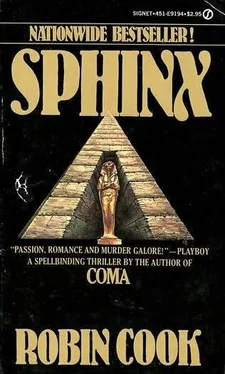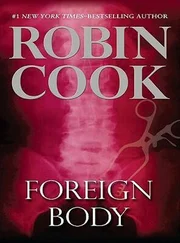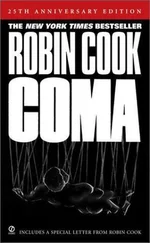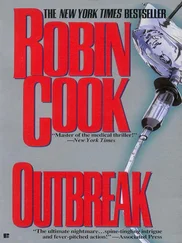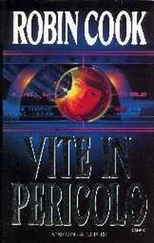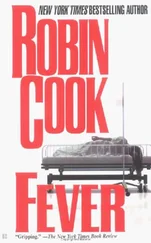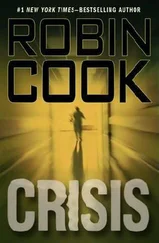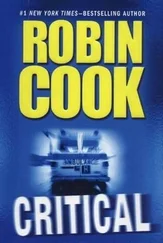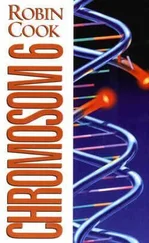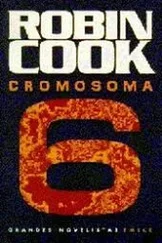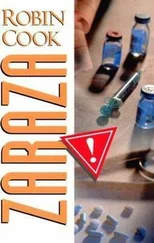It was a pleasant meal. Yvon had a subtle humor that Erica enjoyed immensely. But after the last piece of toast, she was impatient to continue her investigation.
“Well, I’m off to the museum,” she said, folding her napkin.
“Would you care for some company?” asked Yvon.
Erica looked across at him, remembering Richard’s impatience. She did not want to feel rushed. It was better to go alone.
“To be truthful, the kind of work I want to do is going to be a bit boring. Unless you want to spend the morning in the archives, I prefer to go by myself.” Erica reached across the table and touched Yvon’s arm.
“Fine,” he said. “But I’ll have Raoul give you a ride.”
“It’s not necessary,” she protested.
“Compliments of the French,” said Yvon cheerfully.
Dr. Fakhry led Erica into a small stuffy cubicle off the main room of the library. On a single table against the wall was a microfilm reader.
“Talat will bring the film you desire,” said Dr. Fakhry.
“I appreciate your help very much,” Erica told him.
“What is it you are looking for?” queried Dr. Fakhry. His right hand suddenly shook spasmodically.
“I’m interested in the robbers who broke into Tutankhamen’s tomb in ancient times. I don’t think that aspect of the discovery has been given the attention it deserves.”
“Tomb robbers?” he questioned, then shuffled from the room.
Erica sat down in front of the microfilm reader and drummed her fingers on the table. She hoped that the Egyptian Museum had as much material as possible. Talat appeared and gave Erica a shoe box full of film. “You buy scarab, lady?” he whispered.
Without even answering, Erica began to look through the microfilm canisters, conveniently labeled in English with cards from the Ashmolean Museum, which houses the original documents. She was genuinely surprised at the wealth of the material and made herself comfortable, since she was clearly going to be there for a while.
Flipping on the reader, Erica inserted the first roll of film. Fortunately Carter had written his journal in a compulsively neat script. Erica skimmed to the section describing the stonecutters’ huts. There was no doubt that they had been built directly over the entranceway to Tutankhamen’s tomb. Erica was now positive that the robbers had to have plundered Tutankhamen’s tomb before the reign of Ramses VI.
She continued skimming until she came to the section where Carter listed the reasons he was sure before he discovered Tutankhamen’s tomb that it existed. The piece of evidence that Erica found the most fascinating was a blue faience cup with the cartouche of Tutankhamen, found by Theodore Davis. No one had ever wondered why the little cup was found hidden under a rock on the hillside.
When the first spool was finished, Erica put on the next. She was now reading about the discovery itself. Carter described at length the way the outer and inner doors of the tomb had been closed again in antiquity with a seal of the necropolis; the original Tutankhamen seal could only be found at the base of each door. Carter explained in detail why he was certain the doors had been breached and resealed twice, but offered no explanation why.
Closing her eyes, Erica rested for a few moments. Her imagination took her back to the solemn ceremony when the young pharaoh was interred. Then her mind tried to conjure up the tomb robbers. Had they been confident during their robbery, or had they been terrified at the possibility of angering the guardians of the netherworld? Then she thought about Carter. What was it like when he entered the tomb for the first time? From the notes Erica confirmed that he had been accompanied by his assistant, Callender; Lord Carnarvon; Carnarvon’s daughter; and one of the foremen, named Sarwat Raman.
For the next several hours Erica scarcely moved. She could sense Carter’s feeling of awe and mystery. With painstaking detail he described the location of each object: the alabaster lotiform cup and a nearby oil lamp took several pages. As she studied the material on the cup and the lamp, Erica remembered something she’d read elsewhere. On his lecture tour after the discovery, Carter had mentioned that the curious orientation of these two objects led him to conjecture that they were clues to some greater mystery that he hoped would be unraveled following a complete examination of the tomb. He’d gone on to say that the group of gold rings he had found discarded in cavalier manner suggested that the intruders were surprised in the middle of their brigandage.
Looking up from the machine, Erica realized that Carter assumed that the tomb had been burglarized twice, since it had been opened twice. But that was indeed an assumption, and there might be another equally plausible explanation.
After an initial reading of Carter’s field notes, Erica put into the microfilm reader a roll of film labeled “Lord Carnarvon: Papers and Correspondence.” What she found was mostly business letters concerning his support of the archaeological endeavors. She advanced the film rapidly until the dates coincided with the discovery of the tomb itself. As she expected, the volume of Carnarvon’s correspondence increased once Carter had reported finding the entrance stairway. Erica stopped at a long letter Carnarvon had written to Sir Wallis Budge of the British Museum on December 1, 1922. In order to get the entire letter in one frame, it had been reduced considerably in size. Erica had to strain to read the script. The handwriting also wasn’t as neat as Carter’s. In the letter Carnarvon had excitedly described the “find” and listed many of the famous pieces Erica had seen in the traveling Tutankhamen exhibit. She read along quickly until a sentence leaped out at her. “I have not opened the boxes, and don’t know what is in them; but there are some papyrus letters, faience, jewelry, bouquets, candles on ankh candlesticks.” Erica looked at the word “papyrus.” As far as she knew, no papyrus had been found in Tutankhamen’s tomb. In fact, that had been one of the disappointments. It had been hoped that Tutankhamen’s tomb would have afforded some insight into the troubled era in which he lived. But without documents, that hope had been destroyed. But here Carnarvon was describing a papyrus to Sir Wallis Budge.
Erica went back to Carter’s notes. She reread all the entries made the day the tomb was opened and for the following two days: Carter did not mention any papyrus. In fact, he alluded to his disappointment that there were no documents. Strange. Going back to Carnarvon’s letter to Budge, Erica was able to cross-reference with Carter’s notes every other article he mentioned. The single discrepancy was the papyrus.
When Erica finally emerged from the dreary museum, it was early afternoon. She walked slowly toward the busy Tahrir Square. Although her stomach was empty, she wanted to accomplish one more errand before returning to the Meridien Hotel. From her tote bag she withdrew the cover of the Baedeker and read the name and address, Nasef Malmud, 180 Shari el Tahrir.
Crossing the massive square was an accomplishment in itself, since it was filled with dusty buses and crowds of people. At the corner of Shari el Tahrir she turned left.
“Nasef Malmud,” she said to herself. She did not know what to expect. Shari el Tahrir was one of the more fashionable boulevards, with smart European-style shops and office buildings; 180 was a modern marble-and-glass high-rise.
Nasef Malmud’s office was on the eighth floor. Riding in an empty elevator, Erica remembered the long midday break and was afraid she would not be able to see Nasef Malmud until later in the afternoon. But his office door was ajar and she walked in, noting the sign that said “Nasef Malmud, International Law: Import-Export Division.”
Читать дальше
